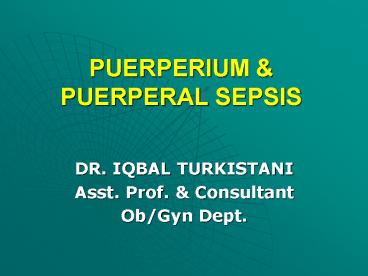PUERPERIUM - PowerPoint PPT Presentation
1 / 15
Title:
PUERPERIUM
Description:
PUERPERIUM & PUERPERAL SEPSIS DR. IQBAL TURKISTANI Asst. Prof. & Consultant Ob/Gyn Dept. PUERPERIUM =The time during which: - all the physiological changes of ... – PowerPoint PPT presentation
Number of Views:1593
Avg rating:3.0/5.0
Title: PUERPERIUM
1
PUERPERIUM PUERPERAL SEPSIS
- DR. IQBAL TURKISTANI
- Asst. Prof. Consultant
- Ob/Gyn Dept.
2
- PUERPERIUM
- The time during which
- - all the physiological changes of
pregnancy is reversed - - and the pelvic organs return to their
previous state - - and endocrine influence of the placenta
is removed - 6 wks( 40 days) 1st two weeks, the
changes are rapid become slower thereafter. - ? Lactation is established
- ? It is a time of physiological and mental
adjustment to the new environment with the
arrival of a new baby
3
- OBJECTIVES OF MEDICAL NURSING CARE DURING THE
PUERPERIUM - 1. Monitor physiological changes of puerperium
- 2. To diagnose and treats any
- postnatal complications
- 3. To establish infant feeding
- 4. To give the mother emotional support
- 5. To advise about contraception
4
- I THE PELVIC ORGANS
- 1. Uterine involution
- ? after delivery uterine fundus palpable
at level of umbilicus - ? 10-14 days later, disappears behind the
symphysis pubis. - ? This process is aided by oxytocin during
breast feeding - ? Delay in involution infection or
retained products of placenta
5
- 2. THE CERVIX
- ? After delivery flacid and
curtain like - ? Few days ?original form
- consistency
- ? External os dilated (one finger
(weeksmonths) - Internal os is closed to less
- than one finger by the 2nd
- week of the puerperium.
6
- 3. THE VAGINA
- ? 1st few days of puerperium, vaginal wall
is smooth, soft and oedmatous - ? Slight distention return to normal
capacity in few days - ? Episiotomy and tears of vagina and
perineum heal well. - ? Healing is impaired in presence of
haematoma or infection
7
- 4. ENDOMETRIUM CAVITY
- ? Decidua is cast off as a result of
ischemia ? lochial flow - ? Lochia blood, leucocytes, shreds of
decidua and organisms. - ? Initially dusky red, fades after one
week, clears within 4 weeks of delivery. - ? New endometrium grows from basal layer of
decidua.
8
- OTHER SYSTEMS
- Bladder Urethra
- - Within 2-3 weeks ?hydroureter and calycial
- dilatation of pregnancy is much
less evident. - - Complete return to normal ? 6-8 weeks
- - Diuresis during first day
- Blood
- -- ? Plasma volume
- - Blood clotting factors and platelet
- count rise after delivery
- - Fibrinolytic activity (which occurs
9
- COMPLICATIONS OF THE PUERPERIUM
- SERIOUS AND SOMETIMES FATAL DISORDERS
- MAY ARISE DURING THE PUERPERIUM
- I. Thrombosis Embolism
- One of the main causes of maternal
death. - II. Puerperal Infection
- ? Puerperial Pyrexia
- A clinical sign that merits careful
investigation. - A temperature of 38 oC on any
occasion in the first 14 days delivery.
10
- CAUSES
- 1. Urinary tract infection
- 2. Genital tract infection
- 3. Pelvic / intra-uterine
- infection
- 4. Breast infection
- 5. Deep vein thrombosis (DVT)
- 6. Respiratory infection
- 7. Other non-obstetrics causes
- 8. Surgical wounds e.g. C.S.
11
- DX / INVESTIGATION
- Full Clinical Examination
- MSU
- Cervical HVS
- Sputum C/S (if possible)
- Blood culture
- MANAGEMENT
- After investigation is sent for
- Start antibiotics if situation warrants
12
- III. MASTITIS
- i. Acute intramammary mastitis
- due to failure of milk withdawal from a
lobule - Rx ? breast feeding, cold compress
, antibiotics if no improvement
within 24 hrs. - ii. Infective mastitis
- May be due to staph. Aureus
- Rx. Antibiotics according to sensitivity
- iii. Breast abscess formation
- Rare but preventable
- Rx.- Surgical drainage if established.
- - antibiotics, only if early.
13
- IV. SECONDARY POSTPARTUM HAEMORRHAGE
- Excessive blood loss from genital tract
more than 24 hr and within 6 weeks of
delivery - Causes
- i. Retained placental fragments
- ii. Blood clots
- Usually within a few days of delivery
- (Commonest between 8-14 days)
14
- MANAGEMENT
- ? Mild bleeding ?observe
- ? IV fluid /blood oxytocic drug
- ? Evacuation of uterus under GA if
- - USS suggests presence of
- retained placental tissue
- - Heavy bleeding persists
- - the uterus is larger than
- expected and tender the cervix is
- open.
- - The infection is treated
- appropriately.
15
- V. PUERPERIAL MENTAL DISORDERS
- i. Fourth day blues
- ? anxiety and depression
- ii. Puerperal psychosis
- ? Uncommon, however serious
- ? ? Due to endocrine changes in
puerperium, or are an - uncovering of an underlying
psychotic tendency at a - vulnerable stage.
- ? Psychiatrist opinion is seeked hence
risk of suicide and - safety of baby are paramount
consideration. - ? Warning signs Confusion,
restlessness, extreme - wakefulness, hallucination and
delirium - TREATMENT































